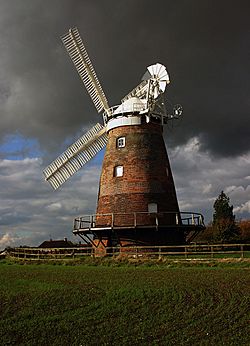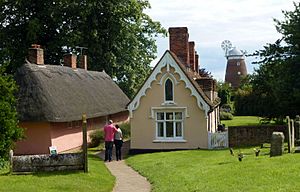John Webb's Mill, Thaxted facts for kids
Quick facts for kids John Webb's Mill |
|
|---|---|

The restored mill, October 2004
|
|
| Origin | |
| Mill name | John Webb's Mill Lowe's Mill |
| Grid reference | TL 609 308 |
| Coordinates | 51°57′09″N 0°20′28″E / 51.9525°N 0.3410°E |
| Operator(s) | The Thaxted Society |
| Year built | 1804 |
| Information | |
| Purpose | Corn mill |
| Type | Tower mill |
| Storeys | Five storeys |
| No. of sails | Four sails |
| Type of sails | Patent sails |
| Windshaft | Cast iron |
| Winding | Fantail |
| Fantail blades | Eight blades |
| No. of pairs of millstones | Three pairs |
| Size of millstones | 5 feet (1.52 m), 4 feet 6 inches (1.37 m) and 4 feet 3 inches (1.30 m) |
John Webb's Mill, also known as Lowe's Mill, is a historic tower mill located in Thaxted, Essex, England. It is a very important building, listed as Grade II* (which means it's a particularly important building of more than special interest). The mill was once fully working again, but it is currently not in use because one of its large sails broke in April 2010.
Contents
History of the Mill
Building the Windmill
John Webb's Mill was built in 1804. A local farmer and landowner named John Webb had it constructed. He wanted to meet the growing need for flour in the local area and in London. The mill was built using materials found nearby. The timber came from two local farms, and the bricks were made in the nearby Chelmer Valley. John Webb also owned the land where the bricks were made.
How the Mill Got Its Names
The mill was always operated by millers with the last name Lowe or by people named John Webb. This is how the mill got both of its names: John Webb's Mill and Lowe's Mill. The mill stopped grinding grain for money in 1910.
Saving and Restoring the Mill
For more than 20 years, the mill was not used. Then, the Thaxted Civic Trust stepped in to help. They made important repairs and made sure the building was waterproof. The lower parts of the mill were even used as a scout hut for a while. In the 1950s, the Thaxted Parish Council took ownership of the mill. Later, in 1964, The Thaxted Society was formed. This group has been very important in getting the mill fully working again.
Recent Events at the Mill
In 2004, the top part of the mill (called the cap) and its sails were taken off. This allowed workers to fix the brickwork at the very top of the tower. These repairs were finished by the end of that year. The mill was officially reopened on April 8, 2005, by Lord Petre.
However, on April 5, 2010, a part of one of the sails broke. The large sail fell to the ground, damaging the platform around the mill. Luckily, no one was hurt, even though six or seven visitors were inside the mill at the time. Today, the ground and first floors of the mill also have a small museum. It displays old farming tools and items.
How the Mill Works
John Webb's Mill is a tower mill with five floors. It has a rounded top, called a cap, with a walkway around it. An eight-bladed fantail helps turn the cap so the sails face the wind. There is also a platform, or stage, on the first floor.
Mill Dimensions
The base of the mill tower is about 24 feet (7.3 meters) wide. At the top, where the cap sits, it is about 15 feet (4.6 meters) wide. The tower itself is about 48 feet 6 inches (14.78 meters) tall. It seems to have been made taller by about 4 feet (1.2 meters) at some point. The total height of the mill, including the cap, is about 54 feet (16.46 meters). The brick walls are about 4 feet (1.2 meters) thick at the bottom. They become thinner at the top, about 18 inches (457 millimeters) thick.
Inside the Mill
The mill has a cast-iron shaft that holds the sails. This shaft connects to a large brake wheel with 88 teeth. This wheel turns a smaller wooden wheel, which then turns a strong upright shaft made of cast iron. A very large wheel, about 8 feet 10 inches (2.69 meters) across, has 122 teeth. This wheel powers three smaller gears, which then turn the millstones. The millstones are large, heavy stones that grind the grain into flour. They are about 5 feet (1.5 meters), 4 feet 6 inches (1.37 meters), and 4 feet 3 inches (1.30 meters) in diameter.
When it was first built, John Webb's Mill had a wooden shaft and four simple sails. It could grind grain with two pairs of millstones. A third pair of millstones was added later. By 1890, the mill had four "double Patent sails," which were more advanced. In the early 1900s, it was working with two double Patent sails and two single Patent sails.
Millers Who Worked Here
- John Webb (1823)
- Lowe (1837)
- John Webb (1848–1853)
- Harry Lowe (1907–1910)
Visiting the Mill
You can visit John Webb's Mill in the afternoon on Sundays and Bank Holidays. It is usually open from May to September. You can also arrange a visit at other times by making an appointment.
The Mill in Movies
John Webb's Mill even appeared in a movie! It was used in a scene for Pier Paolo Pasolini's 1972 film version of The Canterbury Tales. The mill, which looked old and worn before it was restored, was in the background. It appeared during a conversation between the Summoner, the Devil, and the Old Woman in "The Friar's Tale." It's interesting to note that using a 19th-century tower mill in a story set in medieval England is an anachronism. This means something is out of place in time.


